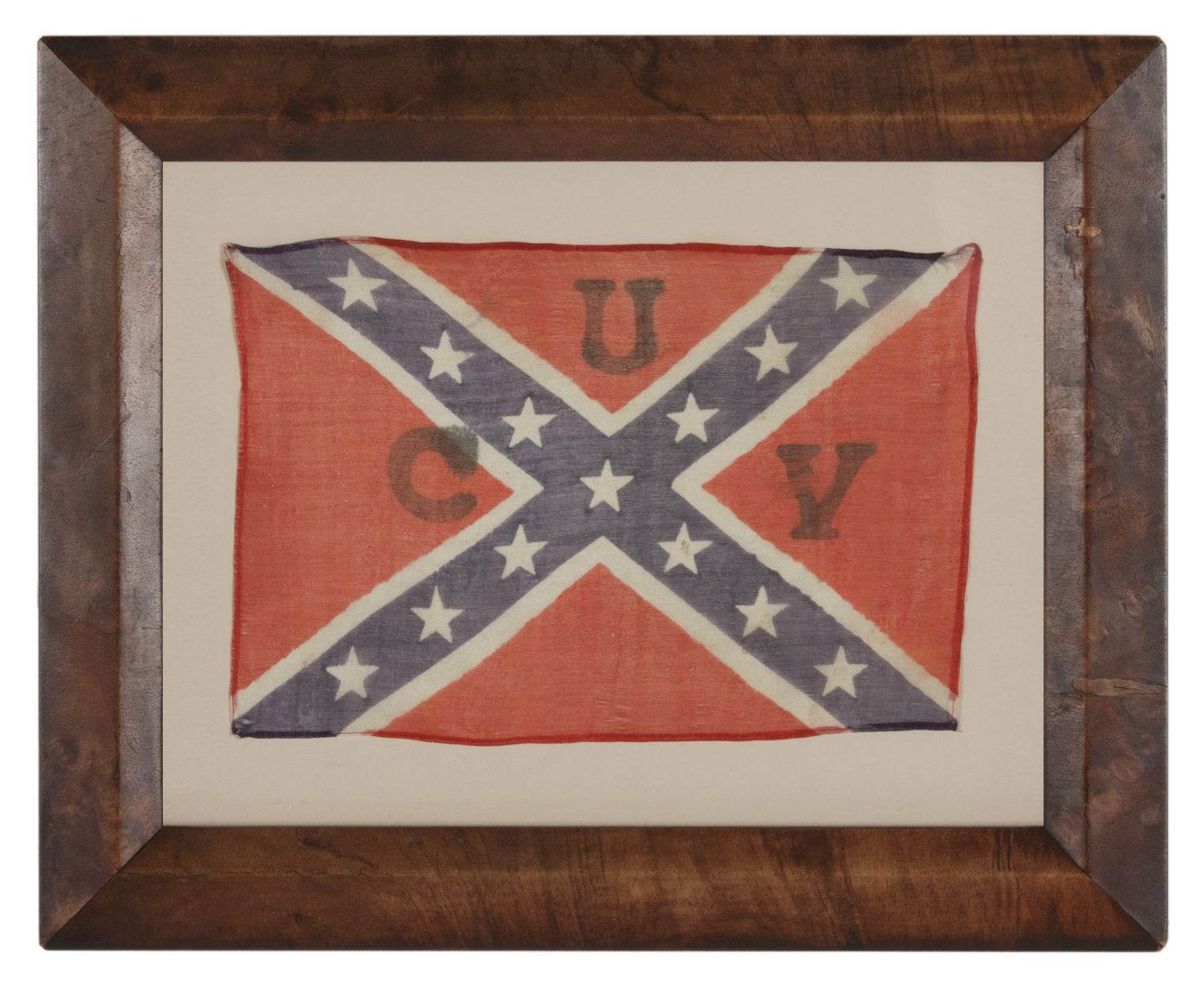
| |
RECTANGULAR VERSION OF THE CONFEDERATE BATTLE FLAG / SOUTHERN CROSS FORMAT, A PARADE FLAG WITH A “UCV” (UNITED CONFEDERATE VETERANS) OVERPRINT, IN A STYLE THOUGHT TO HAVE BEEN MADE FOR THE LAST REUNION OF CONFEDERATE SOLDIERS IN 1951 |
|
| Available: |
Sold |
| Frame Size (H x L): |
11" x 13.5 |
| Flag Size (H x L): |
6" x 9" |
|
| Description....: |
|
Confederate parade flag in a rectangular Southern Cross format, printed on rayon, thought to have been a variety used at the last reunion of living Confederate veterans in 1951. In that year, the United Confederate Veterans (U.C.V.), held its sixty-first and final event in Norfolk, Virginia, from May 30th - June 3rd. By this time, just one last man remained "standing" from the long grey line. That was Pleasant Riggs Crump, who afterwards passed on the very last day of that same year, at the age of 104. Crump had enlisted in 1864 and mustered into the 10th Alabama Infantry, Company A. He was present at Appomattox Courthouse for Robert E. Lee's surrender.
The construction of the flag is akin to other parade flags of the same era. One is a Stars & Stripes format with 49 stars, produced during a one-year time span, between 1959 and 1960, following the addition of Alaska as the 49th state, yet before the addition of Hawaii. Another is a variety in the design of the flag of the State of Israel, thought to have been produced when it gained sovereignty in 1948. The manufacture of flags in this variety of rayon, which is very sheer, was extremely short-lived.
Many people are surprised to learn that this was not the national flag of the Confederate States of America. Officially, in rectangular format, it served as the Confederate Navy Jack. In square format it came to be called "the battle flag" partly because it was carried for that purpose by Robert E. Lee and his Army of Northern Virginia, as well as by Beauregard's Army and others. In some places, such as Tennessee, it was carried on land in rectangular format as well, for the same purpose. The Southern Cross received widespread love in the South, because the three, successive, official national flag designs were not particularly admired by Confederate soldiers.
The United Confederate Veterans (UCV), formed in 1889 and served as the primary post-war organization for Confederate soldiers. The Daughters of the Confederacy (UDC), which was established in 1884, came first and actually preceded the men. Few Confederate flags can be found that date to the early portion of the reunion period, partly because public celebration of war service by Southerners was slow to come, and partly because of the poverty that plagued the South for decades following the Civil War. That changed with the arrival of the new century, which led to an escalation in Confederate flag production.
Some Notes on the Last Surviving Union Soldiers:
The last surviving Union veteran is considered to be Albert Woolson of New York, who died in 1956 at the claimed age of 108. Census records showed he was actually 106. The next-to-the last was James Albert Hard, also of New York, who passed in 1953 at the claimed age of 111. Census research indicates that he was probably a year or two younger, as well, and may have inflated his age to gain service. The last surviving Union Army General was Union Brevet-Brigadier General Aaron S. Daggett of Maine, who died in 1938, the year of the 75th reunion of the Battle of Gettysburg, a major Blue & Grey event.
Notes on Rayon Production:
Synthetic silk (viscose/rayon) was invented by Swiss chemist Georges Audemars in or around 1855, but the fabric did not see commercial production until the 1890's. Initially manufactured abroad, this cellulose-based, semi-synthetic fabric wasn't produced in quantity in the U.S. until 1910, when Avtex Fibers Incorporated became the first large scale maker. Far cheaper to produce than 100% natural fibers, by the 1920's, the import of foreign-made rayon was destroying the American textile manufacturing industry.
Mounting: The veneered, burled wood molding has a double-beveled profile and dates to the period between 1890 and the 19-teens. The flag has been hand-stitched to 100% cotton rag mat. Spacers keep the textile away from the glazing, which is U.V. protective glass.
Condition: There is some bleeding and pigment loss in the black lettering and there is very minor soiling and bleeding elsewhere. Many of my clients prefer early flags to show their age and history of use. |
|
|
|
| Collector Level: |
Beginners and Holiday Gift Giving |
|
| Flag Type: |
Parade flag |
|
| Star Count: |
|
|
| Earliest Date of Origin: |
1951 |
|
| Latest Date of Origin: |
1951 |
|
| State/Affiliation: |
The Confederacy |
|
| War Association: |
1861-1865 Civil War |
|
| Price: |
SOLD |
|
| |
Views: 2353 |
|
|
|

